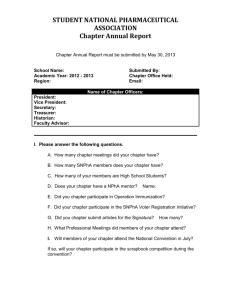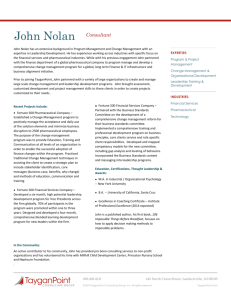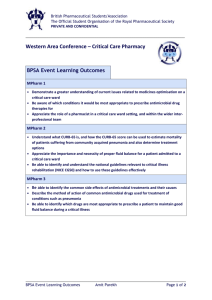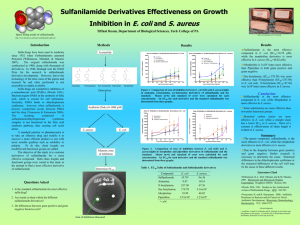ppt13
advertisement
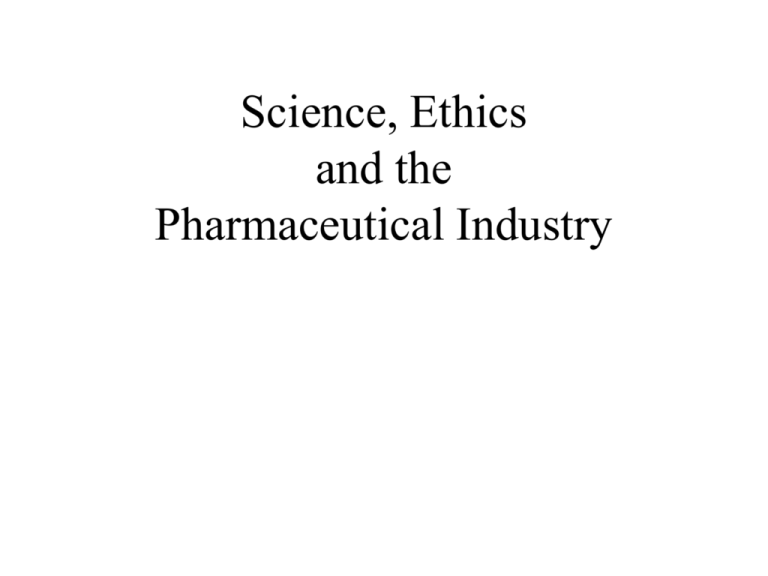
Science, Ethics and the Pharmaceutical Industry The Age of High science in American Medicine 1935- Golden ages • The golden age of public health 1880-1920 • The golden age of surgery, c. 1880 • The golden age of medical practice 19001960 • The golden age of scientific (pharmaceutical) medicine 1935-? U.S. Leading Causes of Death - 1900 Diphtheria 40.3 Senility 50.2 Cancer and other malignant tumors 64 All accidents 72.3 Nephritis (all forms) 88.6 Deaths per 100,000 population Intracranial lesions of vascular origin 106.9 Diseases of the heart 137.4 Diarrhea, enteritis, and ulceration of the intestines 142.7 Tuberculosis (all forms) 194.4 Pneumonia (all forms) and influenza 202.2 0 50 100 Source: Leading Causes of Death, 1900-1998, Centers for Disease Control and Prevention 150 200 250 U.S. Leading Causes of Death - 1974 Bronchitis, emphysema, and asthma 12.6 Certain causes of mortality in early infancy 13.5 Arteriosclerosis 15.1 Cirrhosis of liver 15.6 Diabetes mellitus 17.5 Deaths per 100,000 population Influenza and pneumonia 25.7 Accidents 49 Cerebrovascular diseases 97.2 Malignant neoplasms, including neoplasms of lymphatic and hematopoietic tissues 169 Diseases of heart 346 0 50 100 Source: Leading Causes of Death, 1900-1998, Centers for Disease Control and Prevention 150 200 250 300 350 400 U.S. Leading Causes of Death - 1992 Homicide and legal intervention 10.5 Human immunodeficiency virus infection 11.7 Suicide 12.2 Diabetes mellitus 19.4 Pneumonia and influenza 30.9 Deaths per 100,000 population Accidents and adverse effects 35.4 Chronic obstructive pulmonary diseases and allied conditions 35.9 Cerebrovascular diseases 56.9 Malignant neoplasms, including neoplasms of lymphatic and hematopoietic tissues 204.1 Diseases of heart 285.9 0 50 100 Source: Leading Causes of Death, 1900-1998, Centers for Disease Control and Prevention 150 200 250 300 350 Cures • Rabies vaccine, 1888 • Diphtheria antitoxin, 1891: concept of stimulating immune system • Salvarsan, 1907 – 606: concept of toxic receptors • Insulin, 1921, addition of normal bodily substances • Sulphanilimide, 1935, penicillin, 1941, streptomycin, 1944: antibacterial agents • Corticosteroids, 1948 The emergence of clinical “SCIENCE” • The Paris Hospitals, early 19th century • PCA Louis and the numerical method, 1830s1840s This image is © Wellcome Images, available under a Creative Commons License. – Hospital as an experimental site – Very large (tractable) patient populations – Bleeding does not improve pneumonia • Karl Pearson (1857-1936) – Mathematics of correlation and regression http://commons.wikimedia.org/wiki/File:Karl_Pearson.jpg • Raymond Pearl (1879-1940) – Application of Pearsonian statistics in medicine, 1940s http://en.wikipedia.org/wiki/Raymond_Pearl The pharmaceutical industry • Pharmacopeias: lists of recognized medicaments (and modes of preparation): Problems of strength – – – – – 11th century Arabia 1618: London Royal College of Physicians 1820: U.S. Pharmacopeia 1888: National Formulary 1906, 1938: accepted as legal standards • www.usp.org • Proprietaries: Hamlin’s Wizard oil • "Rheumatism, toothache, deafness, burns, bites of dog, quinsy, diphtheria, gastralgia, cholera morbus, bleeding gums,... and just about everything else!" • Ethicals: laudanum Image courtesy of the National Library of Medicine, National Institutes of Health. Lydia Pinkham http://commons.wikimedia.org/wiki/File:Lydia_Pinkham.png http://en.wikipedia.org/wiki/File:LydiaPinkham-VegetableCompound.gif Regulation of the pharmaceutical industry • Federal Pure Food and Drugs Act, 1906 (the Wiley Act), section 8, Mislabeling In the case of drugs” – FIRST. If it be an imitation of or offered for sale under the name of another article. – SECOND. If the contents of the package as originally put up shall have been removed, in whole or in part, and other contents shall have been placed in such package, or if the package fail to bear a statement on the label of the quantity or proportion of any alcohol, morphine, opium, cocaine, heroin, alpha or beta eucaine, chloroform, cannabis indica, chloral hydrate, or acetanilide, or any derivative or preparation of any such substances contained therein. • Problems: Pinkham’s vegetable tonic (20% alcohol) • Amendment 1912 allows action against “false and fraudulent” claims – Http://www.fda.gov/opacom/laws/wileyact.htm Empirical age of pharmacology (to mid 1950s) • • • • Lots of new compounds; interest in families of compounds Assumption of structural molecular specificity Little knowledge of HOW drugs work Drug testing in the 1930s – Safety, but new uses and combinations • Rasmussen’s classes – Free-lancers: established clinical scientists – Efficient: wannabe clinical scientists: practitioners with access to patients – Friendly experts: the insidious “general consultant” Regulation of the pharmaceutical industry/2 • 1937 Sulfanilamide incident: • Elixir Sulfanilamide: sulfanilamide + diethylene glycol + raspberry flavoring • 100 deaths: • Defense • "We have been supplying a legitimate professional demand and not once could have foreseen the unlooked-for results. I do not feel that there was any responsibility on our part.“ • Fined, under 1906 act for mislabeling (elixir = alcohol)[ Photo courtesy of U.S. Food and Drug Administration. Regulation of the pharmaceutical industry/3 • Leads to passage of Foods, Drugs, and Cosmetic Act, 1938, est. FDA – Amendments, 1940s, to 1951: • lead to prescription-only drugs after 1951 • Requirements for pre-approval testing • Medical Advertising – After 1951, to gatekeeper physicians – After 1980s, to public • Back to consumer medicine It’s my body: why not let me choose? • Problem of drugs; diagnostic techniques – – – – Efficacy, 1962, enforced after 1970 False positives and negatives Risk (or tolerance)-benefit ratio Presumption of universal human • State interests in citizenry vs therapeutic liberty – Ecological interests – veterinary antibiotic use • Inability to choose – OTC vs prescription Controlled trials (and epidemiology) • 1. Diagnostic accuracy – Disease + patient + stage • 2. Meaningful control • 3. Elimination of bias ideally double blind • 4. agreed measures of success • 5. Meaningful long-term follow-up • Problematic before serology: large numbers mask • Complicated conceptually in epidemiology and ethically in treatment trials • Presumes biomedical model of cure • Requires standardized modes of measurement • Requires enormous commitment of social workers, statisticians: Even necessary? The concept of clinical trials • Arrowsmith’s trials of plague antidote: St. Hubert – Gottlieb’s instruction: follow the Protocol – Sondelius’ capitulation: follow Gottlieb – Arrowsmith’s capitulation: save lives, sacrifice science • The Reception of Arrowsmith: science is a hard but noble master Federal funding of medical research • Pre WWII – Rockefeller Foundation • Rockefeller Institute, New York – A De Witt Tubbs/Simon Flexner • Carnegie Foundation – Flexner Report – U.S. Public Health Service Hygienic Institute • Joseph Kinyoun • Goldberger, pellagra, 1935 • Theobald Smith, Rocky Mountain Spotted Fever Federal funding/ 1930 NIH (Bethesda, 1938) 2 • 1937 National Cancer Institute — grants to outside researchers • 1941 Committee on Medical Research : mass production of malaria, artificial quinine, leads to CDC 1946 • 1950 NSF: peer review grants • overall fed expenditure on medical research – – 1941 c. 3 million 1951 76 million • National heart institute, 1948, NIMH 1949 (374K to 42.6 mil by 1962), • Child development, juvenile delinquincy, television violence, suicide prevention, alcoholism • Separation of Surgeon General’s office 1968 – http://www.hhs.gov/ophs/ Image courtesy of Office of NIH History, National Institutes of Health. 27 Institutes: How many do you know? • • • • • • • • • • • • • NCI NEI NHLBI NHGRI NIA NIAAA NIAID NIAMS NIBIB NICHD NIDCD NIDCR NIDDK • • • • • • • • • • • • • • NIDA NIEHS NIGMS NIMH NINDS NINR NLM CIT CSR FIC NCCAM NCMHD NCRR CC http://www.nih.gov/icd/index.html Federal funding/3 1938 usphs total = 2.8 m • 1945 180,000 for research alone • 1947 4 million for research alone • 1950 46 m for NIH alone • 1955 81 m “ • 1960 400 m “ • no similar funding for increasing medical education. The politics of public medicine: medical advocacy • National Foundation for Infantile Paralysis, 1937 — march of dimes • Salk vaccine, 1952: an upper class disease • American Cancer Society, (Mary Lasker)1948-49 Mary Lasker in front of one of her paintings Photo courtesy of the National Library of Medicine, National Institutes of Health.




